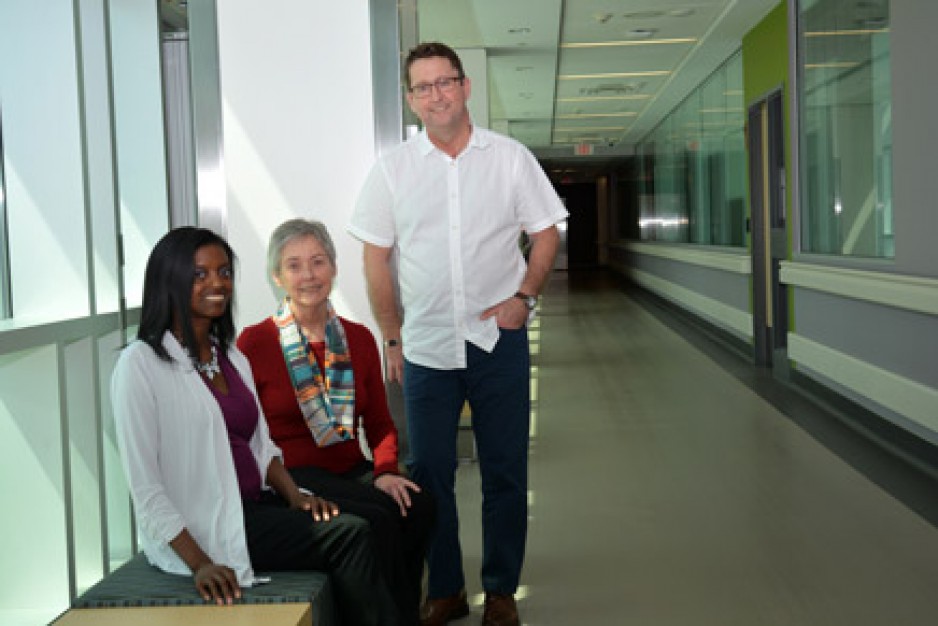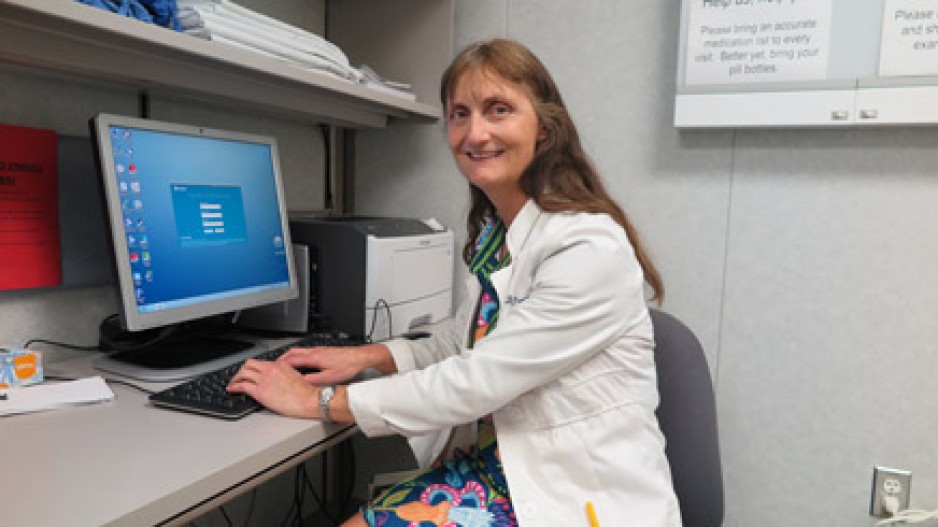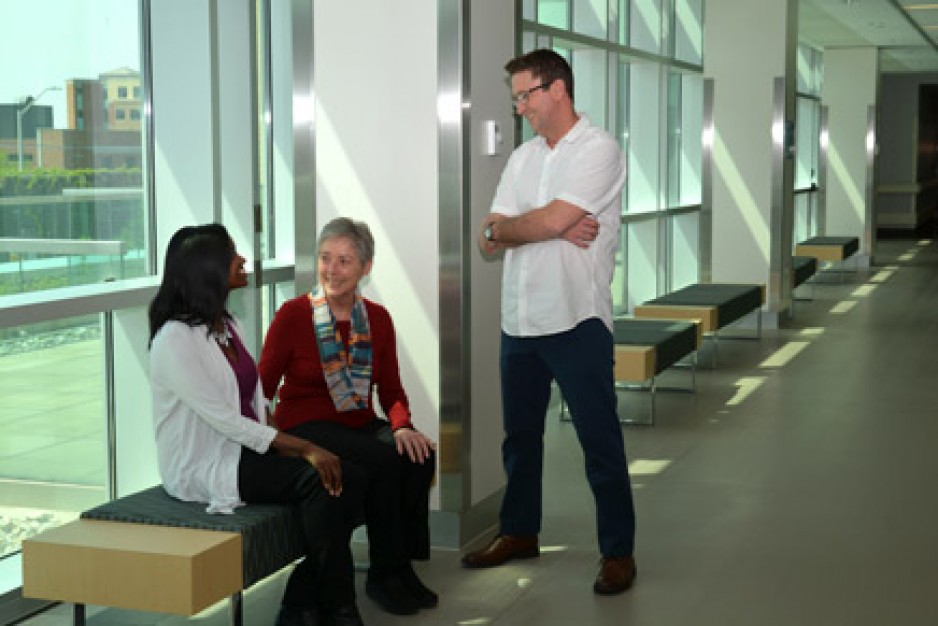With knowledge, comes hope
With only about two in every 10,000 people in Canada living with scleroderma, it can be a lonely journey for these individuals. But at a support group based at St. Joseph’s Health Care London (St. Joseph’s), people with scleroderma can find the strength, education and care they need.
It’s a natural fit to base the support group at St. Joseph’s where rheumatologist Dr. Janet Pope, Chair/Chief of the Division Head of Rheumatology, and her team specialize in scleroderma care and research.
Derived from the Greek words sclero meaning hard and derma meaning skin, scleroderma is a chronic, autoimmune, rheumatic disease that hardens connective tissue. With scleroderma, something causes the immune system to go haywire and start attacking tissues as it is an autoimmune disease. Thinking there is an injury to repair, the cells are fooled into making too much collagen. The collagen builds up in tissues causing them to become hard and fibrous, which causes organs to malfunction.
“There are many different manifestations of scleroderma that vary in severity and rate of progression,” explains Dr. Pope. “While some people have only mild symptoms, for others it can be life threatening. In fact, scleroderma is the most lethal connective tissue disease – even more so than lupus and myositis. Examples of its destructive path may include scarring the lungs, obliterating pulmonary arteries, hampering the absorption of nutrients due to gut involvement, and causing kidney crisis.” For nearly every person with scleroderma their fingers are tight, making even dressing and eating a problem.
There are two types of scleroderma – localized and systemic sclerosis. Localized is hardening of the skin in a localized area of the body either in a line or in patches. While not fatal, localized scleroderma may impact quality of life because of changes to the skin, restricted movement at joints, and in some cases, deformities of the face and extremities. Systemic sclerosis affects connective tissue in many areas including blood vessels, joints, skin, esophagus, heart, lungs, and other internal organs.
Dr. Pope’s support of those with scleroderma transcends the hospitals’ walls. Her encouragement was key in the local Scleroderma Support Group establishing the Walk, Run or Ride for Scleroderma in London, which takes place on June 2 this year starting in Gibbons Park.
“Not only does this walk raise awareness about scleroderma, it also raises funds for scleroderma research which will help us unravel the mysteries of this disease,” says Dr. Pope, who is also a researcher at St. Joseph’s.
St. Joseph’s is the regional centre for all rheumatic diseases including scleroderma. However, patients often come from much further afield, including other provinces, to get the expert care they need. Dr. Pope’s team also consults with other rheumatologists throughout Ontario, as well as those throughout Canada, to share knowledge so t patients receive optimal care without having to travel to London.
“For people living with this rare disease, we can offer them knowledge,” says Dr. Pope, “and with knowledge, comes hope.”
Living with Scleroderma
Bea Kiekens, Ashton Forrest and Paul Ouimet have travelled three very different paths with their scleroderma, but finding others on a similar journey through a support group has been healing.
When Bea, 75, found out she had scleroderma 20 years ago, she just wanted a magic pill to make it go away. She soon found out you can’t make this chronic disease go away, but knowledge about the disease is a powerful tonic in learning to live with scleroderma. She is instrumental in London’s Scleroderma Support Group and the Walk, Run or Ride for Scleroderma.
“It’s important for people with scleroderma to come together in the support group to exchange information and experiences managing scleroderma, and to open up and speak freely. To know they are not alone,” says Bea.
Bea’s scleroderma is progressing slowly. Her symptoms include tight, hardened skin, obstructed blood flow to her fingers and toes, difficulty swallowing because her esophagus is hardening, and dramatic increases and decreases in blood pressure.
Two years ago, in a demanding job as a restaurant operations manager, Paul began experiencing muscle pain, weight loss and fatigue. Only 43 at the time, he thought he was just getting old. When he met with Dr. Pope, she confirmed he had scleroderma and noticed how rapidly it was progressing in his lungs. Consulting with Paul’s respirologist, Dr. Marco Mura, Dr. Pope tried to slow down the progression with drugs, but the scarring from the scleroderma in Paul’s lungs was impacting his ability to breathe.
“It got to the point where I never went anywhere – not even on my honeymoon – without an oxygen tank,” says Paul.
With all other options exhausted, on Sept. 11, 2017, Paul was put on the list for a lung transplant. Incredibly, just six days later in a seven and a half hour surgery, Paul received a new pair of lungs. Today, he can shovel the driveway, go for walks and is working out again.
“For me, it really took a team – from Dr. Pope, to my respirologist, to my transplant specialist, to my friends and family – to get me where I am now.”
For Ashton Forrest, attending the Scleroderma Support Group meetings is like a get together with family.
“We’re among people familiar with the situation; people who really understand your pain; people who still have hopes and dreams and who are living rich lives despite their health challenges.”
When Ashton was 21, her health took a dramatic turn. Her face and lips became swollen and white patches appeared on her face and chest, and she began to experience exhaustion, acid reflux, chronic pain, and difficulty breathing. Her skin was so tight she needed assistance getting dressed. At Western University at the time, other students in her classes did not know or understand anything about scleroderma as it is so rare.
Today Ashton, 31, splits her time between studying for her masters of philosophy degree, advocating for people with a disability and tending to her medical needs.
“I don’t want to miss my life waiting to get better. I want to continue living my life and see what happens.”
For those just starting out it with a diagnosis of scleroderma, it’s scary, adds Ashton. “It’s new territory. But once you find the right people to support you – people who make you feel like you and not the disease – it won’t take over your life. It just becomes one of the many facets of your life.”
Bea’s story
When Bea Kiekens, 75, found out she had scleroderma 20 years ago, she just wanted a magic pill to make it go away. She soon found out you can’t make this chronic disease go away, but knowledge about the disease is a powerful tonic in learning to live with scleroderma.
Bea, a former real estate broker, has the type of scleroderma that is progressing slowly. Her symptoms include tight, hardened skin, obstructed blood flow to her fingers and toes, difficulty swallowing because her esophagus is hardening, and dramatic increases and decreases in blood pressure.
“It’s such a complicated machine we live in,” says Bea. “Often people with scleroderma look well on the exterior, so it may be hard for others to understand why I have to cancel plans at the last minute because the disease is sapping my energy and causing me pain and discomfort.”
Bea is instrumental in the London branch of the Scleroderma Patient Support Group, which meets at St. Joseph’s Hospital. “It’s important for people with scleroderma to come together to exchange information and experiences managing scleroderma, and to open up and speak freely. To know they are not alone.” Bea credits the group’s success to Dr. Janet Pope, whose tremendous support includes connecting them with guest speakers who are experts in their respective fields of medicine.
Bea’s advice for anyone newly-diagnosed with scleroderma is to find a patient support group. “When you’re first diagnosed, it is so frightening,” she says. “It’s such a relief to talk to other patients.”
Paul's story
Two years ago, in a demanding job as a restaurant operations manager, Paul Ouimet began experiencing muscle pain, weight loss and fatigue. He thought he was just getting old. There is no way Paul, then 43, could have imagined that scleroderma would wreak such havoc on his lungs that just 18 months later he would need a double lunch transplant.
Lung problems are one of the most serious complications of systemic scleroderma.
When Paul was referred to Dr. Pope, she confirmed he had scleroderma, and noticed how fast it was progressing on his lungs. Consulting with Paul’s respirologist, Dr. Marco Mura, Dr. Pope tried to slow down the progression with drugs, but the scarring from the scleroderma in Paul’s lungs was impacting his ability to breathe.
“It got to the point where I never went anywhere – not even on my honeymoon – without an oxygen tank,” says Paul.
With all other options exhausted, on Sept. 11, 2017 Paul was put on the list for a lung transplant. Incredibly, just six days later in a seven and a half hour surgery, Paul received a new pair of lungs. “In a blink, I went from signing up for a transplant to being home for Christmas,” he recalls.
Today, Paul can shovel the driveway, go for walks and is working out again.
For those who have just found out they have scleroderma, he recommends they get as much information as possible and begin treatment quickly. “For me, it really took a team – from Dr. Pope, to my respirologist, to my transplant specialist, to the support group, to my friends and family – to get me where I am now.”
Ashton's story
For Ashton Forrest, attending the Scleroderma Support group meetings is like a get together with family.
“We’re among people familiar with situation; people who really understand your pain; people who still have hopes and dreams and who are living rich lives despite their health challenges.”
When Ashton was growing up, she was always energetic and involved in sports. When she was 21, her health took a dramatic turn. Her face and lips became swollen and white patches appeared on her face and chest, and she began to experience exhaustion, acid reflux, chronic pain and difficulty breathing.
Today, 10 years after she was diagnosed, Ashton splits her time between studying for her masters of philosophy degree at Western University, advocating for people with a disability and tending to her medical needs.
“I don’t want to miss my life waiting to get better. I want to continue living my life and see what happens.”
Ashton’s advice for people newly-diagnosed with scleroderma is to get their family and caregivers involved so they understand the impact of the disease. She also emphasizes the importance of not going straight to the internet for information. “Don’t read the snake oil on the internet; instead reach out to your doctors and get information from accredited resources.”
“For those just starting out, it is scary. It’s new territory, but once you find the right people to support you – people who make you feel like you and not the disease – it won’t take over your life. It just becomes one of the many facets of your life.”


